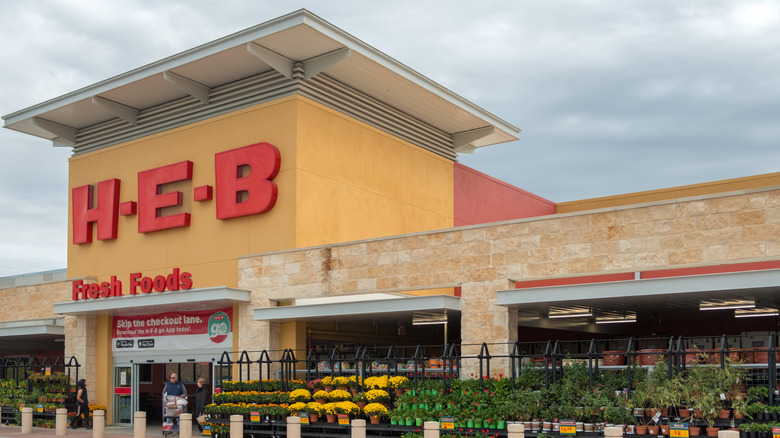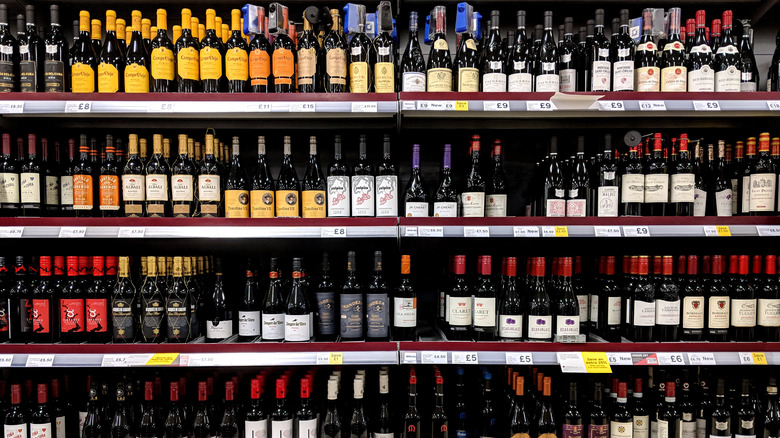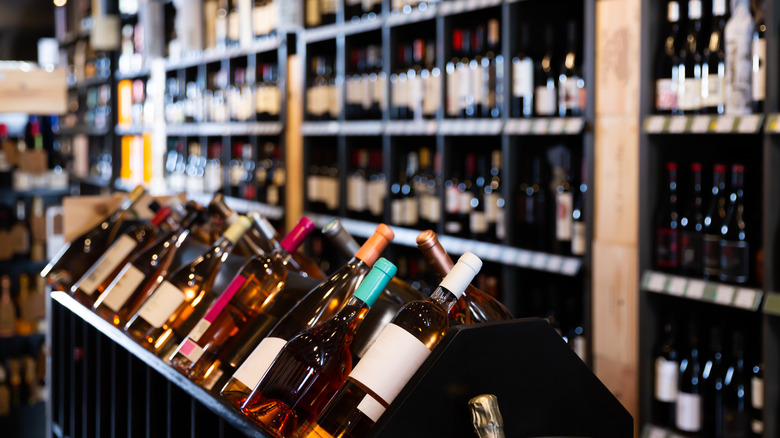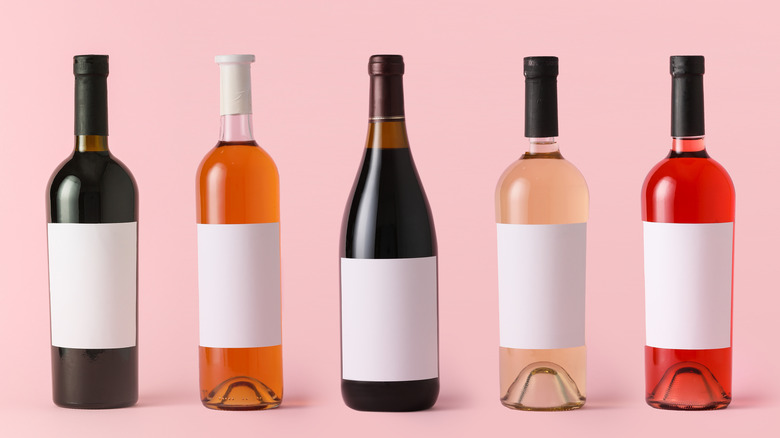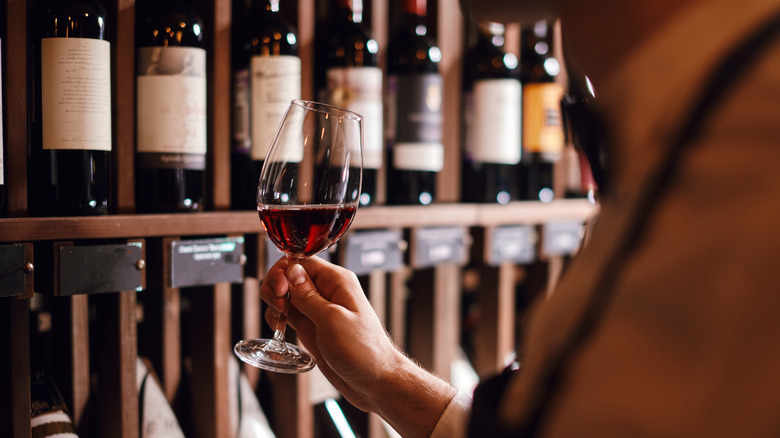H-E-B Wine: What To Know Before You Buy
In 2020, Food & Wine named the Texas supermarket chain H-E-B among its picks for the top 10 grocery stores in the country. The source describes how the chain implemented a standard emergency plan for disasters early on during the pandemic, resulting in a smooth transition as grocery shopping took on a whole new look. For a company that started off in 1905 as a small general store and slowly developed into a larger presence, the outcome has been successful — many even joked H-E-B should run for president, says the article.
Customers surely appreciated the great lengths that the store went to in order to assure safety and precaution throughout the course of the last year. Nevertheless, H-E-B's constant affordability, high-quality products, and wide range of services were already enough to reel in its customers. Whether you're looking for household items, groceries, a pharmacy, or more, you're likely to find it at H-E-B. For many shoppers, that means buying a bottle of wine to go with the all the household goods. H-E-B is equally ready to fulfill its clients' needs on this front, as well, with a notable selection of varietals to choose from in its shopping aisle.
More about H-E-B's wine selection
The Texan grocery store H-E-B might not seem like a go-to place to purchase wine, but the chain's selection is actually quite varied. Unlike some larger stores that might stick to a small number of basic options or only sell a private label, H-E-B stocks products from the U.S., Europe, South America, and Australia. In fact, the wine category on H-E-B's website lists more than 1,400 products including white, red, rosé, sparkling, dessert, and boxed wines. Regardless of your budget and preferences, you should be able to find something to your liking when browsing through this supermarket's wine aisle.
Dan Schuette, the director of H-E-B's wine and beer department, explains to Market Watch that he selects products with the store location in mind, saying, "We tailor each store layout and assortment — including beer and wine — to what we think is right for its specific market." Schuette adds that on top of his regular selection of wines, he has almost 1,000 more choices that he stocks in certain stores. To keep the options fresh and interesting, every two years H-E-B reassesses what they sell. For now, Cabernet Sauvignon leads the way among the most popular varietals, with Chardonnay close behind (per the Market Watch article). This trend is matched in the national statistics reported by USA Wine Ratings.
When did H-E-B start selling wine?
According to Thrillist, the popular supermarket chain H-E-B only started selling alcohol in 1976, even though it first opened in 1905. Nowadays, as evidenced by the expansive wine and beer program, H-E-B has shifted to providing their customers with all of their grocery needs, understanding the close tie that exists between wine and food. Aside from offering a wide selection, the store has also taken great care to educate a team of staff in order to better facilitate the process of choosing and buying wine.
A few years ago, Grocery Dive reported that the supermarket giant had expanded and begun selling wine and beer through their delivery platform as well. Thanks to the profitable sales and interest from loyal customers, this extra step in augmenting their wine and beer sales has been worth it. The chain appears to be eager to maintain their alcohol sales and the permanent product in their stores is certainly popular.
What is the price of the wine at H-E-B?
As with all wines, the price per bottle at H-E-B varies widely depending on its origin, production, and overall quality. H-E-B sells a wide range of options to satisfy all budgets, whether you like to skimp or splurge. A quick look at the online selection shows prices that start at a couple dollars for a bottle, up to more than $200 for a finer selection (via H-E-B). When you buy six or more bottles, the store even offers a 10% discount to encourage stocking up.
According to Market Watch, H-E-B's wine and beer sales top $1 billion, which suggests consumers are on board with their offerings and buy from here regularly. The source also notes that H-E-B beer and wine prices are on par with the market rate, which makes the store a popular place to pick up wine while already getting weekly groceries.
As far as consumer preferences, Market Watch reports that H-E-B's $10 wines are currently top sellers, however, on average, customers are slowly increasing their price cap. Even if it might not be second nature to purchase finer wines at your local supermarket, the truth is that if the selection is made with proper care, the chances of finding special well-made bottles are much greater.
Is H-E-B wine good quality?
Thanks to a dedicated team of wine stewards and specialists, the selection at H-E-B can satisfy both amateurs and connoisseurs. The department director Dan Schuette notes that he seeks out smaller-scale producers and family-owned wineries when choosing his inventory (via Market Watch). Of course, wine preferences are personal but thanks to the wide range of variety at H-E-B locations, there should be choices for all consumers to enjoy. Whether you're looking for popular bottles such as 19 Crimes or iconic classics from the Old World of wine, H-E-B has you covered.
If you're not convinced you'll like the options, Schuette remarks that some locations organize small tasting events so that you can try the wines before purchasing them. As well, the wine section on the H-E-B website is filled with educational articles, food and wine pairing suggestions, and rating charts to make it easier to make an informed decision. There's even an online wine class courtesy of H-E-B's wine stewards (via YouTube) to help guide you.
General nutritional information about wine
It's not uncommon to hear about the wide range of benefits associated with drinking wine in moderation including bottles you may pick up at H-E-B. Nonetheless, Healthline indicates that the relationship between health and wine isn't so direct and it's best to stick to a measured approach. The source notes that resveratrol, an antioxidant especially present in red wine, is often considered to have positive properties. Nutritionist Amy Prior explains to Women's Health that these characteristics may even help reduce inflammation and benefit heart health. Keep in mind that regardless of the possible advantages of drinking wine, excessive consumption has many downsides (via Healthline).
Just like any other product we consume, wine has its own nutritional profile. Wine Folly reports that a six-ounce glass of red or white wine contains anywhere from 100 up to 275 calories depending on the style of wine. The majority of the calories come from the alcohol, followed by carbohydrates. Additionally, Wine Folly indicates that several nutrients including fluoride, manganese, potassium, vitamin B, zinc, and iron are all present in wine in varying quantities. Although a small portion of the population suffers from a sulfite allergy, the majority of people likely will have no adverse effects when drinking wine in moderation (via Bon Appétit).
